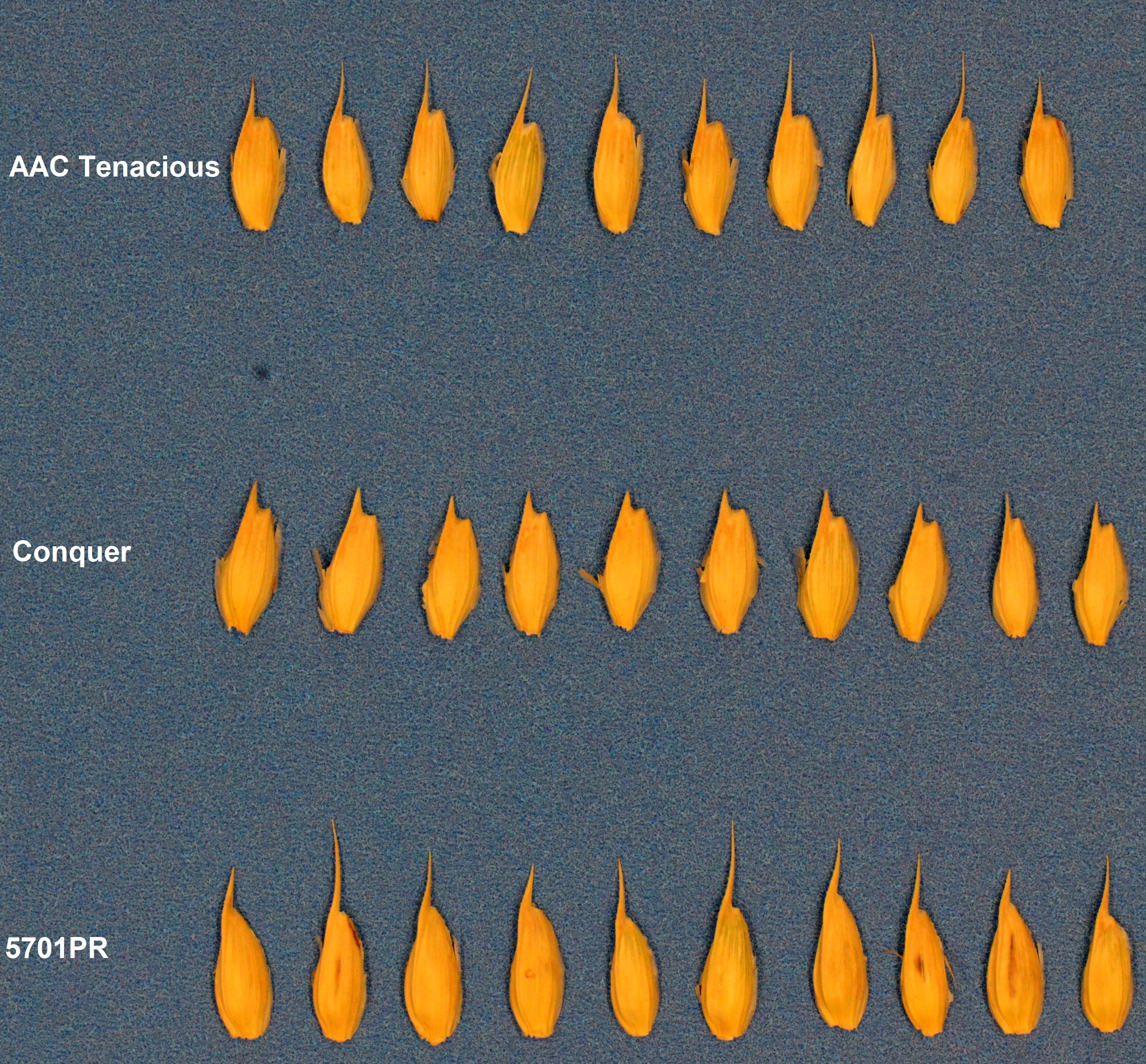AAC Tenacious
| Denomination: | 'AAC Tenacious' |
|---|---|
| Botanical Name: | Triticum aestivum |
| Applicant/Holder: |
Agriculture & Agri-Food Canada, Winnipeg Cereal Research Centre 195 Dafoe Road Winnipeg, Manitoba R3T 2M9 Canada |
| Breeder: |
P. D. Brown, Agriculture & Agri-Food Canada, Winnipeg, Manitoba |
| Agent in Canada: |
Agriculture & Agri-Food Canada Office of Intellectual Property and Commercialization c/o Shannon Whyte 107 Science Place Saskatoon, Saskatchewan S7N 0X2 Canada Tel: (204) 999-9887 |
| Application Date: | 2013-07-08 |
| Application Number: | 13-8084 |
| Grant of Rights Date: | 2017-05-11 |
| Certificate Number: | 5484 |
| Grant of Rights Termination Date: | 2037-05-11 |
Variety Description
Varieties used for comparison: 'Conquer' and '5701PR'
Summary: At the 5 to 9 tiller stage, the growth habit of the plants of 'AAC Tenacious' is erect whereas that of 'Conquer' is semi-prostrate. The glaucosity of the spike of 'AAC Tenacious' is weak whereas it is strong for both reference varieties. The plants of 'AAC Tenacious' are taller than those of both reference varieties. The spike attitude of 'AAC Tenacious' is erect whereas that of 'Conquer' is nodding and that of '5701PR' is inclined. The brush hairs of the kernel of 'AAC Tenacious' are short whereas they are medium length for both reference varieties.
Description:
PLANT: hard red spring type, erect growth habit at the 5 to 9 tiller stage, heads emerge mid-season, mid-season maturity
SEEDLING: absent or very weak intensity of anthocyanin colouration of coleoptile, glabrous lower leaf sheaths and blades
FLAG LEAF: absent or very low frequency of plants with recurved/drooping flag leaves, absent or very weak anthocyanin colouration of auricles, medium glaucosity of sheath, weak glaucosity of lower side of blade, glabrous blade and sheath
CULM NECK: absent or very sparse density of hairiness of uppermost node, strong glaucosity, straight
STRAW: thin pith in cross-section, no anthocyanin colouration at maturity
SPIKE: weak glaucosity, tapering shape in profile, medium density, white at maturity, erect attitude, sparse hairiness of convex surface of apical rachis segment
AWNS: shorter than length of spike, white at maturity
LOWER GLUME: medium oblong shape, medium length and width, glabrous, sparse extent of external and internal hairs
LOWER GLUME SHOULDER: very broad, straight shape
LOWER GLUME BEAK: medium length, straight
LOWEST LEMMA: slightly curved beak shape
KERNEL: medium red, medium size, long, narrow, elliptical shape, rounded cheek, short brush hairs, medium width and depth of crease
GERM: medium size, broad elliptical shape
AGRONOMIC CHARACTERISTICS: good resistance to shattering and pre-harvest sprouting
BREAD MAKING QUALITY: good
DISEASE REACTION: resistant to Leaf Rust (Puccinia triticina), Loose Smut (Ustilago tritici), Fusarium Head Blight (Fusarium graminearum, Fusarium species) and Common Bunt (Tilletia tritici and Tilletia laevis), moderately resistant to Stripe Rust (Puccinia striiformis) and Stem Rust (Puccinia graminis f. sp. tritici)
Origin & Breeding History: 'AAC Tenacious' (experimental designation 'HY1615') originated from the cross 'HY665' / 'BW346' conducted at the Cereal Research Centre of Agriculture and Agri-Food Canada during the winter of 2003-2004. A modified pedigree breeding method was used with contra-season nurseries grown in New Zealand for the F3, F5 and F7 generations to hasten variety development. Seventeen F1 plants were harvested in the 2003 winter greenhouse with minimal selection. In 2004, twenty F2 plots were grown near Glenlea, Manitoba and plants were selected based on height, resistance to lodging, maturity and resistance to rust and Fusarium head blight. F3 plants were grown in New Zealand, selected for leaf rust resistance and straw strength and individually threshed and selected for kernel characteristics. In 2005, the F4 was grown in headrows in the early generation disease nursery in Portage la Prairie, Manitoba. Seed from 18 F4 headrows were advanced to the next generation and increased as an F5 row in an off-season nursery near Palmerston North, New Zealand during the winter of 2005 - 2006. The F5 line was harvested and yield tested as F6 lines in 2006 at Glenlea, Brandon, Saskatoon, and Portage La Prairie. Spikes were collected from the yield plots and increased and purified as F7 rows in 2006-2007 at the off-season nursery near Palmerston North, New Zealand. Eight F6:8 lines were planted and screened in the 2007 F8 yield trial. Several lines from which 'HY1615' was derived were tested in the 2008 Eastern Prairie Wheat - A and the 2009 Eastern Prairie Wheat - B tests. It was evaluated in the 2010-2012 High Yield Wheat Cooperative Test under the denomination 'HY1615'.
Tests & Trials: Tests and trials were conducted during the 2014 and 2015 growing seasons at the Agriculture and Agri-Food Canada Lethbridge Research Centre in Lethbridge, Alberta. Plots consisted of 4 rows per plot with a row length of 3.0 metres and a row spacing of 23 cm. There were 3 replicates arranged in a RCB design. Measured characteristics were based on a minimum of 20 measurements per variety per year. Mean differences were significant at the 5% confidence probability level based on a paired Student's t-test.
Comparison table for 'AAC Tenacious' with reference varieties 'Conquer' and '5701PR'
Plant height (including awns) (cm)
| 'AAC Tenacious' | 'Conquer' | '5701PR' | |
|---|---|---|---|
| mean 2012 | 91.1 | 80.5 | 74.6 |
| std. deviation 2012 | 5.7 | 6.1 | 5.5 |
| mean 2014 | 103.0 | 98.7 | 91.3 |
| std. deviation 2014 | 6.5 | 6.7 | 4.7 |
Click on image for larger view

Wheat: 'AAC Tenacious' (left) with reference varieties 'Conquer' (centre) and '5701PR' (right)
Click on image for larger view

Wheat: 'AAC Tenacious' (top) with reference varieties 'Conquer' (centre) and '5701PR' (bottom)
- Date modified: